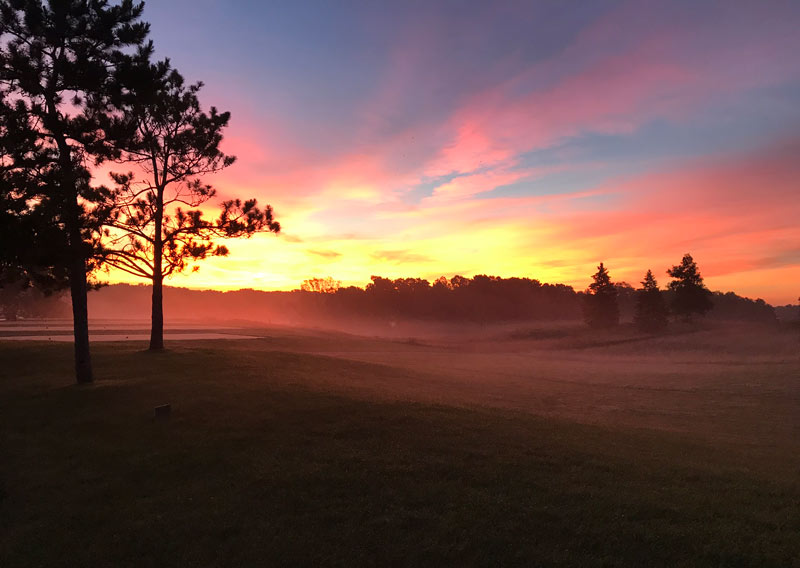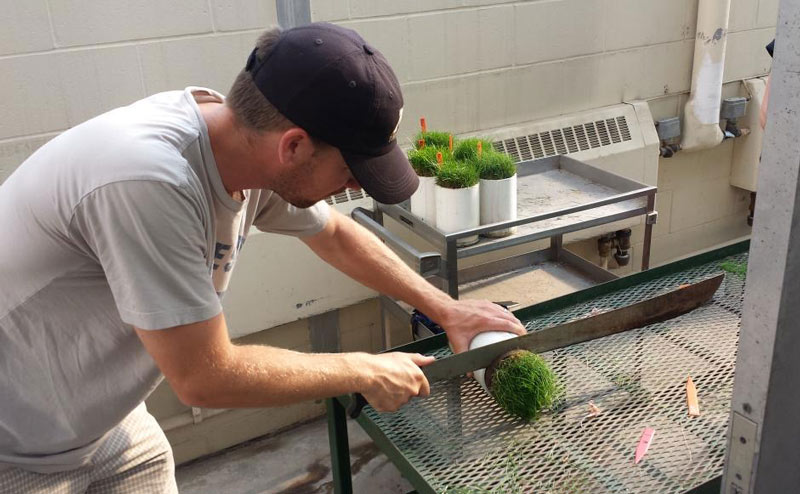
The morning view outside the shop at Rush Creek Golf Club in Maple Grove, Minn., where assistant superintendent Matt Cavanaugh will take the reins as superintendent in January 2021. Photos courtesy of Matt Cavanaugh
Harry Dunne (Jeff Daniels’ character in “Dumb and Dumber”) stares over with a sad look on his face.
“So you’re still an assistant superintendent, huh?”
“Oh yeah. The industry always freaks out if someone stays an assistant for too long,” Lloyd Christmas (Jim Carrey’s character) replies.
Sheepishly, Harry looks over. “Yeah, well, I’ve been an assistant superintendent for 15 years now.”
Lloyd begins to laugh. “Man, you are one pathetic loser. No offense.”
With a resigned expression, Harry waves and says, “No, none taken.”
My name is Matt Cavanaugh (aka Harry Dunne), and I’ve been an assistant superintendent for 15 years — a pretty rare thing. Many of my former colleagues have left the industry over an assortment of reasons — pay was too low, family time suffered because of the long hours, or that top job just never seemed to come their way.
So, why did I stick around? What caused me to take this path, which has finally led to me landing a head superintendent position at the beginning of 2021, at the age of 40?
I finished my undergraduate studies in 2002, and, like many turf graduates just out of school, I had a plan to spend five years as an assistant and then obtain a superintendent job. So, true to form, I applied for my first superintendent role in 2007. Even before getting a reply from the facility I considered to be my new employer, I went to Men’s Warehouse to purchase a suit. Luckily, they were having a BOGO sale — jackpot!
I’m going to look so good for this interview, and I’ll have a bonus suit to wear to my first green committee meeting.
The call for the interview never came, and those two oddly fitting suits are still hanging in my closet today. I sent out a few more résumés in 2007 without a sniff. At the time, I was discouraged, and I didn’t get it. I thought I had all the credentials — a four-year turf degree and five years working at Rush Creek Golf Club, a high-end public golf course in Maple Grove, Minn.
The disappointments of 2007 prompted me to ponder ways to try to differentiate myself from the rest of the applicants for golf course superintendent positions.
I had it!
Let’s go back to turf school (my wife was getting her MBA at the time, so I couldn’t resist the competition anyway). When I was done, what other job candidate would have the great distinction on their résumé of both a bachelor’s degree in turf (agronomy) and a master’s degree in turf (applied plant science)? No one — and I would be a shoo-in for the next job I set my sights on.
From the fall of 2007 to the spring of 2009, I continued to work at Rush Creek while attending classes at the University of Minnesota. My scholastic pursuits included a field research project that started in fall 2007 and had final data collection in spring 2010. This was no small commitment, and it opened my eyes to a whole new side of turf. I learned so much during this time and had many new experiences thanks to speaking engagements based on my no-mow fine fescue research project.
With my thesis defended in the spring of 2011, I was again ready to take a crack at the superintendent ranks. So, with those 4-year-old unworn suits in mind, I sent out résumés with my new master’s in turf clearly highlighted.
Let’s go!
Well, I didn’t get a call.
And I was ticked.
I called up one of the courses and asked for an explanation. I was told that I had a strong résumé, but that they were concerned about the fact that I had been at Rush Creek as an assistant for so long (2002 to 2011). I’d heard of this — a long stint as an assistant — being frowned upon in the industry, but I hadn’t yet experienced any stigma because of it.

Author Matt Cavanaugh researched fine fescue while earning his master’s degree at the University of Minnesota.
I went on to explain why I had been at Rush Creek in the same position for so long — the facility had been incredible in letting me attend class during work time (and still paying my full salary) and use space at the golf course for my field research project. I wasn’t about to leave them high and dry for another position while I pursued higher education in turf.
To this, I got the simple response of, “Oh, that makes sense.” However, that course had already moved on in its superintendent search.
Later on in the summer of 2011, a few weeks after that phone call, I vividly remember being on the first green at Rush Creek, digging a hole to fix an irrigation leak. I was digging angrily and thinking to myself, “I have a master’s degree and I’m still here digging holes. I’m better than this. Why can’t other people see it?”
The grass isn’t always greener
At that point, I was fed up with the golf course superintendent world and looking for any job that would get me out. Friday, Sept. 2, 2011, was my last day at Rush Creek before I started as head of grounds for a local school district. I’d been working in golf since 1995, and this new job was actually my first ever outside the industry (insert picture of me breathing into a paper bag), which, from what I can tell, is quite common in this line of work. We turf people don’t start off very well rounded.
The pace at the school district was considerably slower than I was used to. And the people actually took lunch? Interesting.
Fast-forward to December 2011 (yes, three months): I hated my job and I wanted to be back on the golf course in the worst way. That ship had sailed, though, and this was my first taste of the “grass isn’t always greener” life lesson.
So I applied for another job and landed an interview. And, despite a terrible-looking suit, I was offered this new position. In late December 2011, I started at PBI-Gordon as a sales representative for Minnesota, Wisconsin, North Dakota and South Dakota. The company took a chance on a longtime assistant superintendent/failed head of grounds for a school district.
What a change. I was out of my comfort zone in sales, yet taking on this role with PBI-Gordon was the best thing to ever happen to my career. I met so many people and saw so much more of the industry, namely how other turf managers were doing things, and not just in golf. I gained far more turfgrass knowledge in this sales role than I had in any other role, including all my years as a student. I was able to observe some new turf management tactics, and I was also able to see many things that were done wrong, which was great for me.
Other people do screw up!
It was also wake-up call to discover how little I knew from a product standpoint. As a sales rep, my life became products. From the ones I was selling to the competition’s products to everything else — I wanted to be ready when someone asked me a question, even if it wasn’t about my product. The ability to interact with the distributors, manufacturers and chemists who actually put these products together was invaluable and something that cannot be taught in a class. I didn’t look at the job as a sales role — I thought of it as an educational opportunity. Learn more, sell more.

The par-5 eighth hole at Rush Creek Golf Club, seen from the back tee. The 18-hole course, located about 20 miles from downtown Minneapolis, features creeping bentgrass greens (A1/A4), tees (Penncross) and fairways (Providence).
During my time with PBI-Gordon, my family grew, and, unfortunately, overnight travel became much more difficult on me mentally that I thought it would. I struggled with the fact that I was on the road while my kids were growing up. Although it was hard to leave a great company and a great role at PBI-Gordon, I did decide to leave and take a position as a turfgrass research scientist with the University of Minnesota.
Academia, another huge change. Yes, I knew the group from my days as a master’s student, but this was a much different role. In the assistant superintendent role and the sales role, I’d acquired a lot of practical knowledge and experience. As a research scientist, I looked at the why and how of turfgrass — not just the doing part that most assistant superintendents are accustomed to. The research side delved deeper into the things turf managers deal with. This is where the idea to investigate bentgrass seed germination at low temperatures came from, which subsequently led to me counting 50,000 bentgrass seeds, which I’m still cross-eyed from.
My first passion, however, was always the golf course. Fortunately, through conversations with Rush Creek’s superintendent and general manager, I was able to return as an assistant superintendent at the club in the summer of 2016. I was a much different person this time around, armed with the valuable (and sometimes tough) lessons I’d learned after leaving the course five years before.
Looking back, I was naive to think I could have and should have obtained a superintendent position in 2007. Maybe some are ready for it a few years out of school, but I was foolish to think I was, especially at a larger club. However, by 2011, I was burned out as an assistant and just needed out, and I unfortunately made the wrong decision, which resulted in my full-on face-plant at the school district.
Every single individual looking to become a superintendent would be well served to be on the other side of the industry first, especially the sales side. It’s unlikely this will happen for most, but it has been amazing how differently I have treated the assistant job since resuming it in 2016. Spending those previous five years seeing how other superintendents succeeded — and also failed — has been a huge asset. I’m much more relaxed now in my current role. Many of us, especially as assistants, can become very isolated at our own courses and never gain a perspective of how things are done at other facilities, even with the existence of social media. It’s not the same as interacting face to face.
Editor’s note: Read more from author Matt Cavanaugh in his article Turf Club: Camaraderie, advice off the golf course, where he shares how informal gatherings with a group of fellow turf enthusiasts helped him boost his agronomic IQ and find a sense of community.
Understanding the product side of things has also been a significant boon. It’s not just knowing the brand name — it’s knowing the actual active ingredient and how each active ingredient interacts with the plant. Many in the industry never think beyond the brand name, which I get. It’s easy, but it’s not the best practice for your professional development. Then there’s the people side of it. Sales forces you to meet and interact with all kinds of people — some pleasant, some unpleasant, but all of whom will make you a better manager of people when the time comes.
Commit to the goal, not to the path
I’ll be taking over as the superintendent at Rush Creek Golf Club in January of 2021 for the retiring superintendent. So, why did I wait for this role for nearly 19 years? Better yet, as many of you are probably asking yourselves, why did I come back?
I came back because I finally saw, through leaving the golf course, that this is a pretty great job, and, frankly, it’s easier than the sales role or university role. I think many assistants hang on too long as assistants and eventually get burned out. They hang on because this is what they went to school for and they worry that if they do leave the ranks, they can’t come back. This belief needs to be squashed. So many of us are afraid to try a different post within the industry because of a fear of being ostracized from the golf course management side. Take it from me: Don’t worry about that. The best thing I ever did was come back to the industry, yet it took me leaving to figure this out. Kind of a chicken/egg thing.

Digging the dirty work: Cavanaugh tackling a drainage project in 2017.
Looking back, I was also very pompous and naive, which is a bad combination. I thought that because I’d gone to a four-year turf school, I had it all figured out. It took me leaving the assistant role to understand that I had nothing figured out, and that I’d also had a pretty great gig that I was willing to wait for if it were to ever become available again.
Another thing I realized: There is nothing wrong with a blue-collar job. Golf course superintendents grow a lot of grass and dig a lot of holes — and I love it. I think some people in this industry feel self-conscious about this and go to great lengths to try to prove otherwise. I used to be one of those people, and it has been a huge relief to let that notion go.
One last bit of advice: It’s no surprise that the industry is starving for quality assistants right now, and this provides some pretty good leverage. Don’t be afraid to use that leverage, because a golf course will be rewarded by the assets you bring on board. Don’t give your talents away.
So, I’ve waited to attain the superintendent role at Rush Creek for 18 years since graduating from college and first becoming an assistant superintendent. If my newly graduated self were to ask my 40-year-old self whether he would have a head superintendent job five years after graduation, I’d tell him it’s a one in a million chance. My wide-eyed younger self would probably say, “So you’re telling me there’s a chance.”
Matt Cavanaugh is the assistant superintendent at Rush Creek Golf Club in Maple Grove, Minn., and a 13-year member of GCSAA. A wife-proclaimed “turf nerd,” Cavanaugh started working on a golf course in the summer of 1995, shortly after which the aforementioned golf course was turned into a parking lot. This bump in the road didn’t deter Cavanaugh from pursuing a career in turfgrass management, however. A few classes at Kansas State University and the University of Minnesota have provided him gainful employment in the industry for 18 years. Cavanaugh lives in Minnesota with his wife and two sons.